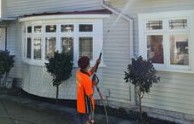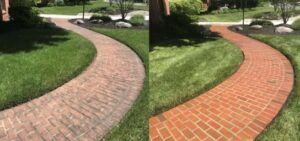
Natural cleaners are your new best friend. How about using some good old vinegar and baking soda? That’s right, these kitchen staples can tackle grime and dirt on most surfaces outside. Lemon juice is another powerful cleaner with antibacterial properties and a fresh scent that’s hard to beat.
If you’re into DIY, you can whip up your cleaning concoction. Mix water, white vinegar, and a little baking soda for a powerful cleaner; some people swear by adding essential oils like tea tree which also have antibacterial and antifungal capabilities that get the job done with an added pleasant aroma.
Water conservation is another key piece of the puzzle. When you’re hosing down your porch or scrubbing the siding, be mindful of water usage. Switching to smaller, more controlled sprays can make a huge difference. Not only does this cut water waste, but it also ensures that those eco-friendly solutions stay where they’re supposed to.
Being eco-friendly is more than just a choice, it’s a lifestyle change that starts with small shifts, like how you clean your outdoor spaces. So the next time it’s time for that deep clean, why not go the green route?
Elevate Your Deck: Tips for a Flawless Finish
Decks can be the jewel of your outdoor space, serving as the perfect spot for a summer barbecue or a quiet morning coffee. But let’s be real, they take a beating from the elements and need a little TLC to look their best.
First up, identifying common deck issues. Wood decks, for instance, can develop mold, mildew, and even rot if not maintained. Composite decks might not rot, but they’re not entirely maintenance-free—stains from BBQ drippings or tannin can dull the surface. Recognizing these issues early means less hassle down the road.
Selecting the right tools is key. A stiff-bristled brush is your first go-to for manual scrubbing, while a pressure washer can make short work of dirt and grime when used correctly. Just don’t go overboard; too much pressure can damage wood fibers on wooden decks.
Speaking of solutions, there are plenty of deck-safe cleaners out there. For those wooden planks, oxygenated cleaners can tackle mold and mildew effectively without the harsh chemicals. Composite decks might benefit from a mild soap mixed with warm water, which can address most stains hassle-free.
Preventing future problems is all about regular maintenance. Applying a sealant not only protects the wood but can also give the deck that just-new-again look. And for both wood and composite decks, keep an eye out for water pooling—ensure proper drainage to minimize damage.
By looking after your deck, you ensure it remains the standout feature of your backyard oasis. Whether you’re hosting guests or simply enjoying your space, a clean deck makes the world of difference.
The Ultimate Driveway and Walkway Cleaning Guide

Driveways and walkways are more than just paths—they’re the welcome mat to your home. Keeping them clean not only boosts your curb appeal but ensures safety from trips and slips.
Knowing what you’re dealing with makes a big difference. Concrete is tough, but it’s porous, which means oil stains can set in fast. Brick walkways add charm but can encourage moss growth. Each material demands a different approach for the best results.
When it comes to tools, a sturdy broom for dry debris and a pressure washer for deep cleaning are your best bets. For those stubborn stains, spot cleaning with a scrub brush might be needed. Got pavers? A leaf blower can help clear off dirt and leaves in no time without disturbing the base.
Let’s tackle the stains. Oil spills on concrete can be tricky; try using a dedicated concrete cleaner or a poultice paste to lift the stain. For those with brick pathways, consider moss or algae cleaners that are non-toxic and safe for the environment, which aren’t going to damage the pathways.
Sealant can be your secret weapon. Post-cleaning, applying a sealant helps resist stains and makes the next clean-up easier. Besides, it adds a polished finish that enhances the surface shine, make sure the concrete is spotless before staining.
Keeping your walkways and driveways pristine is less about hard labor and more about working smarter, not harder. With the right approach, these paths can set the stage for a gorgeous entryway to your home.
Mastering the Art of Window Cleaning for a Streak-Free Shine
Windows are the eyes to your home, and keeping them smudge-free can brighten up your whole space. A little effort here goes a long way—both in terms of aesthetics and energy efficiency.
Let’s start with the basics. Picking the right time for window cleaning is a game-changer. Overcast days are your friend; they prevent streaks that the sun’s rays can create when the glass dries too quickly.
When it comes to tools, simplicity works best. A quality squeegee is essential for a streak-free finish. Pair it with a bucket of warm water mixed with just a drop of dish soap for most grime. And don’t underestimate microfiber cloths—they’re great for touch-ups and wiping edges.
For those tough spots that won’t budge, like mineral deposits from hard water, try using a mix of vinegar and water or a specialized glass cleaner. Gently scrub with a non-scratch pad or razer blade, and they should lift off without too much fuss.
Hard-to-reach windows? Consider using a telescopic pole attachment for your squeegee or invest in a hose window cleaning kit that features a soap dispenser.
Regular cleaning not only maintains clear views but can also extend the life of your windows by preventing glass degradation caused by dirt and grime corrosion over time. Keeping them clean can also mean better insulating properties, leading to a more comfortable home environment, don’t forget the window frames.
With these tricks and tools, window cleaning becomes less of a chore and more of a routine that delivers beautiful clarity and an inviting home.
A Complete Guide to Cleaning Your Roof Safely and Effectively
Taking care of your roof might not seem like a top priority, but it’s a vital part of home maintenance. A clean roof not only enhances your home’s look but can help prevent costly repairs down the road.
Before you start cleaning, it’s crucial to identify any common issues. Moss, algae, and lichen are more than cosmetic problems. They hold moisture against the shingles, which can lead to erosion over time—bad news for your roof’s lifespan.
Choosing the right method depends on your roof material. Asphalt shingles, for example, shouldn’t endure too much pressure in the cleaning process. Instead of a pressure washer, try using a mild cleaning solution designed for roofs. Mixing water with bleach is effective but ensure it’s safe for your roofing type.
If you spray your roof with a mild solution of bleach a little soap to help the solution hold onto the roof and water just before winters rainy season starts the solution will break down the moss algae and lichen and the rain will help wash the roof.
Safety is the number one rule here. Always secure a ladder properly and wear non-slip shoes to prevent accidents. Or better yet, invest in a roof safety harness system if you regularly clean your roof yourself.
Sometimes it’s best to call in experts, especially if you have steep roofs or multiple stories. Professionals have the gear and experience to tackle complicated roof cleaning tasks without damage.
By caring for your roof, you’re protecting your home’s first line of defense against the elements. With regular attention, those shingles will shield you effectively for many seasons to come.
Achieving Stunning Curb Appeal: Power Washing and Beyond
When it comes to giving your home’s exterior a fresh look, soft washing can be a game-changer. It’s like hitting the reset button on all that built-up dirt and grime.
For those trickier materials, consider using a soft wash method. This involves using a low-pressure spray with specialized cleaning solutions. It’s an effective alternative that prevents any damage while still getting rid of unsightly growths like mold and mildew.
Soft Washing Is A Method Of Exterior Cleaning Which Is Known For Cleaning Algae, Mold, and Mildew
Soft washing is known for it’s ability to remove algae, mold, mildew and dirt from exterior surfaces that wouldn’t have been able to be cleaned otherwise.
A using the soft wash method can be used to clean very delicate surfaces such as Dry-Vit. Dry-vit is a very delicate surface so pressure washing a surface like this is simply not an option because it will cause damage.
The process works by using a low pressure chemical pump to apply the soft washing cleaning chemicals and then after a 10-15 dwell time, the cleaning solution is thoroughly rinsed off leaving behind a perfectly clean surface.
Generally soft washing chemicals consist of two parts. The first part is Algicide, this is the part that kills algae, mold, and mildew. It is also great for removing wasps’ nests and spider websites. The most common algicide using in professional soft washing is Sodium Hypochlorite.
The second part of the soft washing solution is the surfactant. This part of the soft washing solution serves many purposes; it allows the algicide to cling to the surface for much longer, keeps the surface wet for longer, and clings to all of the dirt and loose particles on the surface.
At the start of the rinsing process, the surfactant will make it much easier for the bugs, dirt, and cobwebs and rinse away without stubbornly clinging to the walls.
There are many different ways to apply soft wash solution. The most best method for applying soft washing solution is through a 12 volt pump or sprayer but this may take some time. The easiest way is to contact a professional.
Make sure you wear protective clothing and equipment wet weather gear and goggles etc.
The solution is bleached based so may take color out of clothing.
The prep work is important too. Before starting, clear the area of anything that might get in the way. Remove pot plants from the home, water down plants and cover electrical outlets and door locks to avoid any mishaps. A well-prepped site makes the whole process more effective and efficient.
Follow up any washing session with some finishing touches. Applying a protective sealant can preserve the refreshed look, while painting trim or doors in bold, new colors can elevate the aesthetic even more.
Remember, maintaining curb appeal is a continuous process that doesn’t stop with one power wash session. Routine care, possibly incorporating some of the tricks from earlier sections, ensures your home stays the neighborhood star. An attractive exterior isn’t just appealing; it fosters pride and boosts value.
